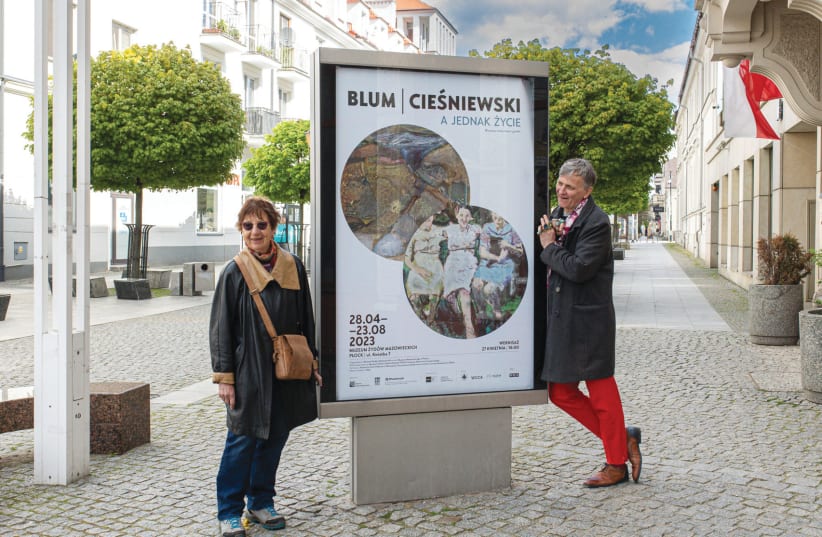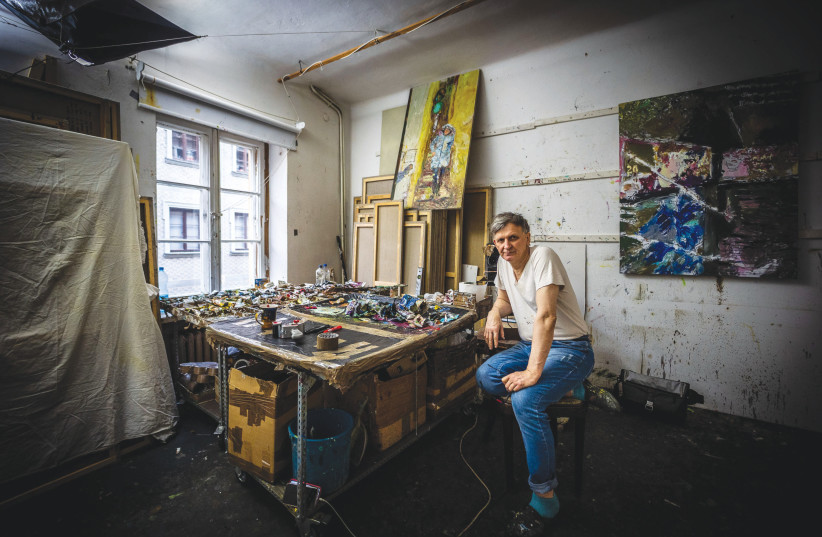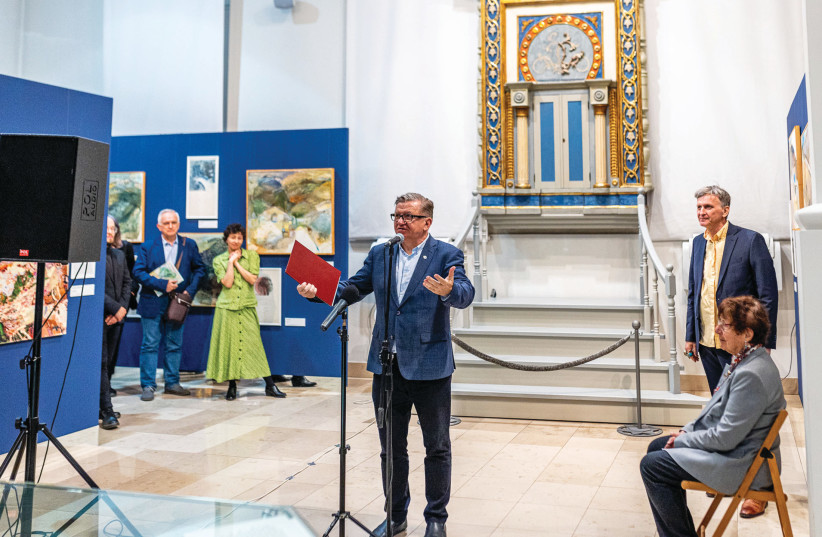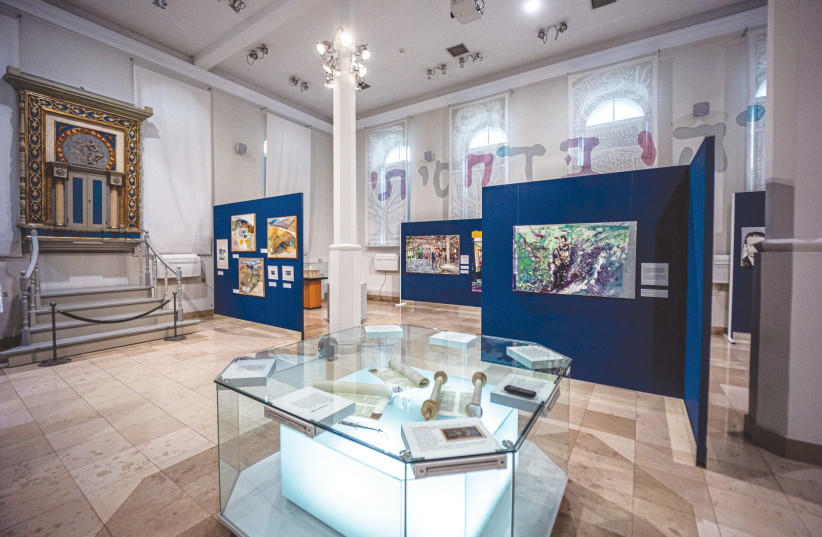We all have our own thoughts and emotions about the Holocaust. Presumably, the farther away the horrific events of the Hitler regime in Nazi Germany and across Europe, and into North Africa, recede into the past, the more we are able to set the murder of six million Jews to one side and get on with our lives.
Sidelined but, hopefully, not ignored forever. Holocaust museums, memorials, and commemorative occasions rightly stress the importance of keeping the memory of those unimaginably terrifying times alive, so they don’t recur.
But what was it like for the ordinary German or Austrian on the street when their neighbors, possibly friends and acquaintances, were summarily ousted from schools, businesses, and their homes, and suddenly disappeared? What was it like, say, for my now nonagenarian mother’s non-Jewish neighbors on Hollandstrasse in Vienna’s Second District when they saw synagogues burning, Jewish stores ransacked, and Jews forced to scrub the sidewalk and marched off to the train station for deportation to concentration camps in Poland?
Have we ever considered what we might have done ourselves had we been Christian residents of Warsaw, Hamburg, Krakow, or Berlin? Would we have cheered the Nazi atrocities as many did? Would we have taken an active role in the persecution of Jews and other non-Aryans as so many did? Would we have stood to one side, hoping to stay out of trouble while secretly outraged by the indescribable cruelty being meted out?
Or, might we have actually done something to help, despite the dangers involved?
What did other Poles do during the Holocaust?
WHEN I recently met Wojciech Ciesniewski in the Warsaw suburb of Otwock, he immediately told me about two Poles who fit into the latter category.
He took me into the local St. Vincent de Paul church and was patently moved while he told me about two priests who had concealed Jews there as the Nazis tightened their stranglehold on the local community. He proudly showed me certificates on the wall of the chapel that testified to the fact that clergymen Ludwik Wolski and Jan Raczkowski have been recognized by Yad Vashem as Righteous Among the Nations for the aforementioned aid. That also included issuing fake birth certificates to young Jewish children so they could survive the Nazi occupation as non-Jews.
Some of the emotion behind Ciesniewski’s connection with the Holocaust, and what the 65-year-old painter and professor at the Academy of Fine Arts in Warsaw is trying to do to honor the memory of the victims, and those who survived the inferno, began to emerge as I got a look at his works. That was primarily when I arrived in Plock, courtesy of my hosts from the Fundacja Wojciecha Ciesniewskiego (Wojciech Ciesniewski Foundation), to see his gripping oil paintings displayed in the “Life, After All” exhibition held at the Museum of Mazovian Jews. The show also included works by 90-year-old Israeli artist Aviva Blum, who survived the Warsaw Ghetto and made aliyah as a teenager.
The title of the exhibition has something of an oxymoronic, if not contradictory, element to it. Blum, who lived in Jerusalem for 60 years before moving to Tel Aviv last year to be near her family, has said in various interviews she has given over the years that she paints in order to forget her traumatic childhood and youth in Poland. Meanwhile, Ciesniewski states unequivocally that he paints to try to keep alive the memory of those who perished, and honor those who survived, like Blum.
There is a similar yin-yang feel to the artists’ painting styles. While Blum leans toward the abstract – notwithstanding the fact that the main theme of her most recent exhibition, at the Biennale Gallery in Jerusalem’s old Shaarei Zedek Hospital building, earlier this year, was the landscapes she viewed from her previous residence in the capital – Ciesniewski’s style is far more visceral and emotive, and tends toward the realistic.
“Life, After All,” which closes this month at the former Plock synagogue venue, which forms part of the Mazovian Museum, is the result of the efforts of a number of Ciesniewski’s like-minded pals – in particular Beata and Jacek Twardowski – the painter’s knowledge of, and keen interest in, the history of Polish Jews, and a degree of serendipity.
Ciesniewski has been delving into local Jewish annals and, specifically, the time of the Holocaust for half a century now.
“My curiosity about ‘what am I aware of?’ began in the early 1970s by asking questions about the history of my hometown of Dzialdowo [160 km. north of Warsaw], as well as its Masurian surroundings,” he notes.
As a youngster, he enjoyed wheeling around the local countryside and got to know every byway and highway in the vicinity. He says he sensed some mystery surrounding the events of World War II and talks of a “wall of silence” maintained by his parents’ generation.
“Cycling in the 1970s carried with it a thread of mystery,” he recalls. “I remember anxiously stepping into overgrown pits, which were unnatural in the forests, near the sites of mass graves from the war.”
That as yet unfathomed morsel of information was stored away for another day. “I knew, as did my colleagues, that, for example, about 10 kilometers east of Dzialdowo near the former Prussian-Polish border, next to the village of Białuty, there were graves of mass murdered Jews. Adults never talked about it; we children never asked; but among ourselves, every now and then we excitedly told each other about some event we had experienced in the Bialuty Forest or in other similar places.
“There being in the forest unnatural basins, I always thought about the crimes of the Germans, about the innocent people killed, and about the Jews, mysterious to me. It was my little Holocaust, although at the time I never used that word.”
It was at high school that Ciesniewski took on the documented facts about the murder of millions of Jews at Auschwitz and Treblinka, and the meaning of the word “ghetto.” That, naturally, informed his evolving life philosophy.
“The history of the Jewish people and their tragic fate has been for me a particular source of thoughts of nonconformity with evil. This is a tormenting ethical problem for me. The Holocaust occupies a place inconceivable in my dimensions, unrepeatable, because once in history immoral people created a program and led to the annihilation of an entire people, the Jewish people.”
Ciesniewski learned about the nefarious side of human nature at a young age, and the persecution of innocent people by totalitarian regimes, as his father was hounded by both the fascists and the Communists.
He maintained that learning curve through his twenties, earning degrees in mechanical engineering and mathematics before eventually settling on art as a career. His awareness of his country’s not-too-distant dark history also, naturally, increasingly informed his creative path.
THE HOLOCAUST was always there, lurking in the back of Ciesniewski’s mind, and he continued to research the topic and take on new information. One particular image that pertained to that harrowing passage of time grabbed Ciesniewski so powerfully that he felt impelled to portray what he saw in his own singular way.
“In the spring of 2022, I painted a motif of three teenage girls with beautiful pubescent shapes dressed in colorful dresses, sitting on a bench against a background of green trees,” he notes. “This motif came from a black-and-white photo on Yad Vashem’s Facebook page, and depicted the alumnae of the David Guzik Children’s Home in Otwock in 1948.”
The children’s facility was established, with the help of a group of Soviet soldiers, soon after the liberation from Nazi occupation, in January 1945. Shortly after that Luba Bielicka Blum – Aviva’s mother, a nurse by training who had saved quite a few Jewish children from deportation to death camps during the war – was appointed director. Aviva spent some time there, as did Chana Grynberg. Both appear in the triad print Ciesniewski reimagined in oils, which prominently features in the “Life, After All” show. Aviva (Wiesia) Blum is on the right, holding a black cat, and Grynberg on the left, flanking Elvira Grossfeld.
Blum Sr.’s courage during the Holocaust and her sterling work to provide children survivors with the chance of a fresh start in life will be officially recognized in Poland when a newly established child psychiatry center in Otwock is named after her.
Grynberg’s daughter Pnina Kaplinsky and her husband, Moshe, were recently hosted at the exhibition by the Fundacja Wojciecha Ciesniewskiego. Kaplinsky says she had known about the snapshot of the three pals for some time.
“There was a copy of the photo in my mother’s box,” she says, adding that she was very moved by the exhibition and the foundation’s work to support Ciesniewski’s efforts to commemorate the Polish Jewish community and ensure that as many people as possible are cognizant of the Nazi atrocities committed on Polish soil. “When I got to Plock and I saw the street posters of the exhibition, and the painting with my mother, that is unbelievable.”
Kaplinsky, too, makes the distinction between state politics and the folk on the street. “The Poles, the non-Jewish Poles, who are exposed to all the denials and lies about the Holocaust [by the Polish state], they are waking up to the Holocaust and to the Jews. They feel the need to ask for forgiveness, notwithstanding the official denials [of any Polish involvement in the murder of Jews].”
Kaplinsky’s road to Plock began when former Jerusalemite now Polish resident Chana Lasman contacted her with regard to her mother. Lasman and her Polish partner have spent years researching Polish Jewry and genealogy, and she was looking to make a film about the Jewish orphanage in Otwock. The documentary has progressed in the interim – a trailer is currently available online (vimeo.com/757506917) – although Lasman is still trying to drum up the funding required to complete the job.
“Chana told me about the exhibition in Warsaw, and that there was a picture of my mother there,” Kaplinsky explains. She was also due to meet Ciesniewski and the Twardowskis in Jerusalem when they came over for Blum’s exhibition, but the logistics proved to be overly challenging. But it all worked out in the end when the Kaplinskys accepted an invitation to Plock and Pnina saw Ciesniewski’s painting of the three girls with her own eyes.
She was also taken with Ciesniewski’s oeuvre and his efforts to keep the memory of those who perished alive, in his own singular artistic way. “There is the black and white of the photograph, and that time and the feeling back then, and the color of Wojciech’s painting.” Not just the polychromic reading of the early post-World War II period. “He said he sees those three young women, and the womb, and that children will be born, and the revival of the Jewish people. He spoke with such emotion about it all.”
That comes across in the close to 40 works in “Life, After All.” It is as if all of Ciesniewski’s pent-up feelings and thoughts about that cataclysmic era came flooding out of him as he set paint brush to canvas in his cozy studio near the Old Town of Warsaw. The man clearly paints, and talks, wearing his heart on his sleeve.
“The girls full of life, almost excited about their problems as maturing teenagers, were for me a metaphor for health and serenity,” he notes. “This photo was as suitable as possible for the message that ‘after the storm comes day,’ that the Jewish people, threatened by devastation, are once again developing their potential in spirit and body.
“I titled this image ‘The Spring of the Nation.’”
IF THIS were a Hollywood script, let’s say a golden era Tinseltown project when we were all a little more innocent and less worldly wise, the Ciesniewski-Blum confluence would have been par for the cinematic course. It seems that even in this postmodern, post-pandemic virtual world, miraculous, happy-ever-after denouements are possible.
“Life, After All” is the second episode in the Ciesniewski Holocaust-related rollout. The first took place exactly a year ago when he displayed 37 of his works at the aforementioned St. Vincent de Paul church, under the patronage of the Twardowskis. It formed part of a series of events marking the 80th anniversary of the decimation the Otwock Ghetto and ghettos in nearby Karczew and Falenica.
Blum got wind of the event. “The image, distributed in print and electronic form, became a trademark of the exhibition and its message,” Ciesniewski explains. “It was one such message that reached the living girl from the photo – Wiesia Aviva Blum.”
Things began to gather pace. Blum duly wrote to the organizers of the exhibition, the Twardowskis, to let them know she was still very much alive, and painting. A few months later, Beata and Jacek hopped on a plane and came to see Blum’s retrospective spread in Jerusalem. Naturally, Ciesniewski came along for the ride.
“In March 2023, I traveled with my friends to Jerusalem for the finale of Aviva Blum’s exhibition,” he recalls. The die for the Plock joint show was quickly cast.
“After spending a few days there [in Jerusalem], and feeling almost euphoric with each other, we packed up and brought back to Poland her six oil paintings and a dozen prints.”
For the past four months, Blum’s works have been displayed near the place of the Holy Ark in the former synagogue in Plock, which serves as a museum that relates the millennium-long history of the now defunct local Jewish community.
The print of the three teenagers, seemingly physically – if not emotionally – revived after their wartime trials, was not the only document of the time that provided Ciesniewski with a launching pad for new reflective renditions. Other characters, including from the prewar years, are dotted through the exhibition as the Polish artist breathes new life into yesteryear faces, some caught in happy times and others clearly showing the effects of repression and persecution.
The Twardowskis and Ciesniewski are now looking for a suitable venue here to present the exhibition to the Israeli public and will make a second visit in the near future.
For his part, Ciesniewski hopes his work can help spread the word and some important lessons.
“People who do not know history are susceptible to manipulation,” he states. “They are susceptible to experiences that are unknown to them in terms of their consequences. They cannot predict the possible consequences of the reality they perceive.”
He feels we need to take a balanced view of life and the forces that impact on us. “My paintings alluding to themes of both good and evil in their message are meant to express my intentions: to create in the viewer a feeling and thoughts of the beauty of life itself.”
Blum comes into that positive equation. “Aviva, though she is not the only one, is a symbol of ongoing life,” Ciesniewski continues, “proof of the integrity of the ideas of life through the effort to express them artistically – with beautiful results. I believe that the history of those who survived the war, including the history of Aviva, is the memory of those whose lives were taken.” ■
For further information: fundacja@ciesniewski.art















